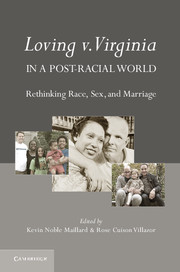Book contents
- Frontmatter
- Contents
- About the Contributors
- Acknowledgments
- Foreword
- Introduction Loving v. Virginia in a Post-Racial World
- Part One Explaining Loving v. Virginia
- Part Two Historical Antecedents to Loving
- 2 Telling Stories of Love, Sex, and Race
- 3 Loving in Indian Territory
- 4 American Mestizo
- 5 Perez v. Sharp and the Limits of Loving
- Part Three Loving and Interracial Relationships: Contemporary Challenges
- Part Four Considering the Limits of Loving
- Part Five Loving Outside the U.S. Borders
- Part Six Loving and Beyond: Marriage, Intimacy, and Diverse Relationships
- Permission Granted
- Index
- References
4 - American Mestizo
Filipinos and Antimiscegenation Laws in California
Published online by Cambridge University Press: 05 July 2012
- Frontmatter
- Contents
- About the Contributors
- Acknowledgments
- Foreword
- Introduction Loving v. Virginia in a Post-Racial World
- Part One Explaining Loving v. Virginia
- Part Two Historical Antecedents to Loving
- 2 Telling Stories of Love, Sex, and Race
- 3 Loving in Indian Territory
- 4 American Mestizo
- 5 Perez v. Sharp and the Limits of Loving
- Part Three Loving and Interracial Relationships: Contemporary Challenges
- Part Four Considering the Limits of Loving
- Part Five Loving Outside the U.S. Borders
- Part Six Loving and Beyond: Marriage, Intimacy, and Diverse Relationships
- Permission Granted
- Index
- References
Summary
In 1933, the California Court of Appeals was faced with the following question: Should a Filipino be considered a “Mongolian”? Salvador Roldan, a Filipino man, and Marjorie Rogers, a white woman, had applied for a license to marry. Was this marriage acceptable under the state’s antimiscegenation laws, which prohibited marriages between “whites” and “Mongolians”? This chapter explores the legal history of prohibition of marriages of whites to Filipinos in the state of California and, in so doing, seeks to reshape the terrain of antimiscegenation laws. The exploration of this history is important given the paucity of legal writing about the Filipina/o-American community and about miscegenation laws targeting Asian Americans in general.
I am particularly interested in complicating how we understand antimiscegenation efforts as they relate to race, gender, class, and sexuality. I also aim to underscore how colonialism and immigration law have shaped our understanding of identity and interracial relationships. By examining the history of antagonism directed against Filipinos in California in the 1920s and 1930s, this chapter illuminates how antagonism against Asians, while economic in its roots, reached its most fevered pitch concerning Filipino relations with white women. This anxiety led to various efforts to classify Filipinos under the state’s antimiscegenation statute as “Mongolian,” so they would be prohibited from marrying whites. As this chapter argues, we can understand these efforts as attempts to shift the legal entitlements bundled with the marriage contract away from Filipino men, symbolizing the desire to deny Filipinos membership in the national political community.
- Type
- Chapter
- Information
- Loving v. Virginia in a Post-Racial WorldRethinking Race, Sex, and Marriage, pp. 59 - 72Publisher: Cambridge University PressPrint publication year: 2012
References
- 1
- Cited by



